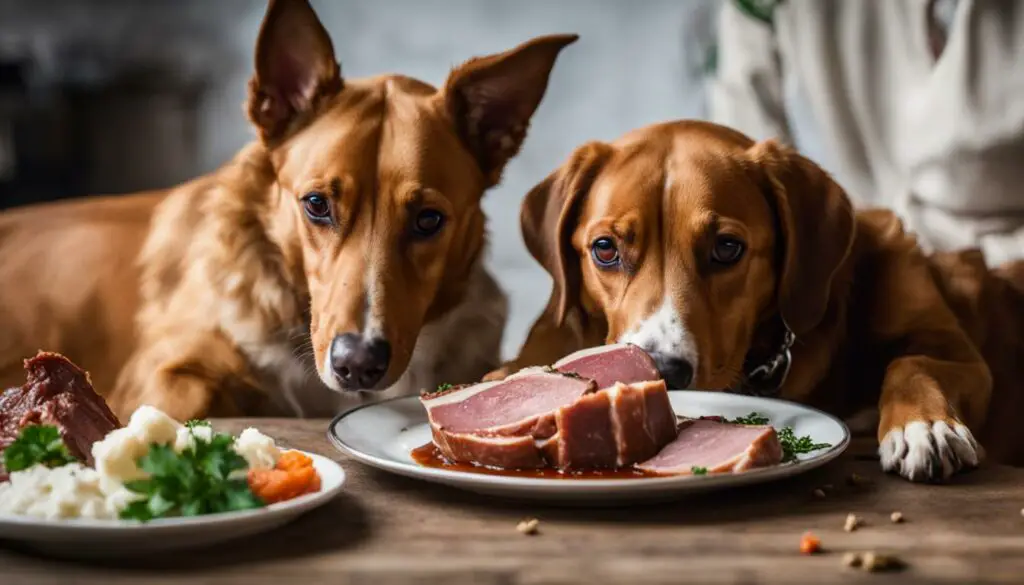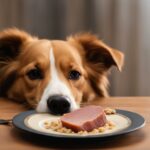As a proud dog owner, I know how important it is to prioritize my furry friend’s health and well-being. That’s why I’ve always been cautious about the foods I give them. I’ve heard mixed opinions about whether dogs can eat ham hock, so I decided to dig deeper and uncover the facts. After thorough research, here’s what I found out about the safety of ham hock for dogs.
While it may seem tempting to share a piece of delicious ham hock with your canine companion, it’s crucial to understand the potential risks associated with feeding them this treat. The United States Food and Drug Administration (FDA) has issued a warning about bone treats for dogs, including ham bones. These treats have been linked to gastrointestinal obstruction, choking, mouth injuries, and even death. It’s clear that giving dogs any type of bone, including ham hock, can lead to various health issues.
Ham hock, like other bones, can become brittle when cooked and easily splinter, posing a risk of choking and internal injuries for your dog. Consuming pork hock can also lead to gastrointestinal problems, such as blockages and pancreatitis. Additionally, ham itself, especially in large quantities, can be harmful to dogs due to its high salt and fat content. Ingredients commonly found in ham, such as garlic and onion, can also be toxic to dogs, affecting their liver and kidneys.
To keep your furry friend safe during the holiday season and beyond, it’s important to be mindful of the foods you share with them. Avoid giving ham hock and other bone treats, and instead opt for safer alternatives specially made for dogs. By prioritizing your dog’s health and well-being, you can ensure they enjoy a happy and healthy life.
Key Takeaways:
- Dogs should not eat ham hock or any type of bone, as they can cause serious health issues.
- Ham hock can splinter when cooked, posing a choking hazard and internal injuries.
- Feeding dogs ham hock can lead to gastrointestinal problems and pancreatitis.
- Ingesting ham, especially in large quantities, can be harmful due to its high salt and fat content.
- Garlic and onion, commonly found in ham, are toxic to dogs and can affect their liver and kidneys.
The Dangers of Ham Hock for Dogs
I want to emphasize the importance of avoiding ham hock as a treat for dogs. Even though it may be tempting to share this delicious food with your furry friend, it can pose serious risks to their health and well-being.
When ham hock is cooked, it becomes brittle and can easily splinter. This poses a risk of choking and internal injuries for dogs. Ingesting pork hock can also lead to gastrointestinal issues, such as blockages and pancreatitis. These conditions can cause discomfort, pain, and even life-threatening complications for your beloved pet.
It is crucial to prioritize your dog’s safety and avoid giving them ham hock as a treat. Instead, opt for safer alternatives that are specifically made for dogs. There are many healthy and delicious treats available in pet stores that will satisfy your dog’s cravings without jeopardizing their well-being.
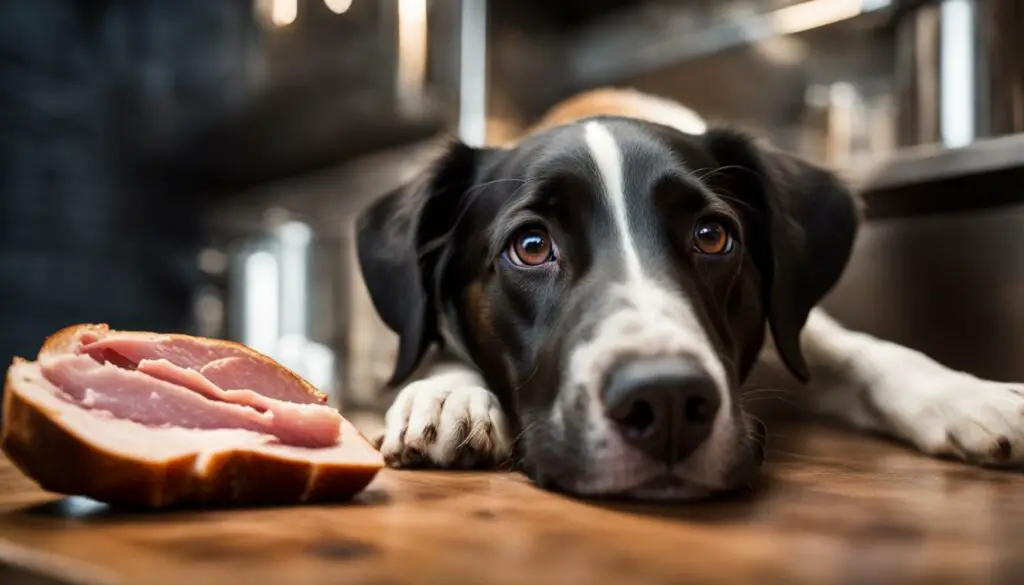
The Dangers of Ham Hock for Dogs:
| Dangers | Consequences |
|---|---|
| Choking Risk | Splintering of ham hock can block airways and cause asphyxiation. |
| Internal Injuries | Brittle ham hock can cause serious injuries to the digestive tract. |
| Gastrointestinal Issues | Consuming pork hock can lead to blockages and pancreatitis. |
As responsible dog owners, it is our duty to keep our furry friends safe and healthy. By avoiding ham hock and opting for safer treats, we can prevent unnecessary risks and ensure our dogs live long and happy lives.
Health Risks of Giving Dogs Bones
Feeding dogs bones, including ham hock, can have serious health risks. Bones can cause a range of issues, from broken teeth and mouth injuries to blockages in the digestive tract. Ingesting bones can also lead to infections and other complications. While dogs are known to enjoy chewing on bones, it is important to understand the potential dangers associated with this behavior and provide safer alternatives for their chewing needs.
The Risks:
- Broken Teeth: Chewing on hard bones can lead to broken teeth, which can be painful and require veterinary attention.
- Mouth and Tongue Injuries: Bones can cause cuts and wounds in the mouth and tongue, leading to pain and potential infections.
- Blockages: Bones, particularly when swallowed in large pieces, can block the digestive tract, causing discomfort, vomiting, and potentially life-threatening obstructions.
- Infections: Consuming bones can introduce bacteria into the dog’s mouth and digestive system, leading to infections and other health complications.
Given the potential risks involved, it is crucial to find safer alternatives for dogs to chew on. There are bone-like products available on the market that are made with safe materials specifically designed for dogs. These products provide a satisfying chewing experience without the dangers associated with real bones.
Safe Alternatives:
If your dog enjoys chewing, consider providing them with the following safe alternatives:
- Chew toys made from durable materials such as rubber or nylon.
- Interactive treat puzzles that stimulate their minds while satisfying their natural chewing instinct.
- Rawhide alternatives made from vegetable-based ingredients.
- Bully sticks or dental chews that are specifically designed to promote dental health.
By offering safe alternatives, you can keep your dog entertained and satisfied while minimizing the risk of injury or health complications.
Table: Comparison of Bone Risks
| Risks | Bones | Safe Alternatives |
|---|---|---|
| Broken Teeth | High | Low |
| Mouth and Tongue Injuries | High | Low |
| Blockages | High | Low |
| Infections | High | Low |
Table: Comparison of bone risks, highlighting the potential dangers associated with feeding dogs bones compared to safer alternative options.
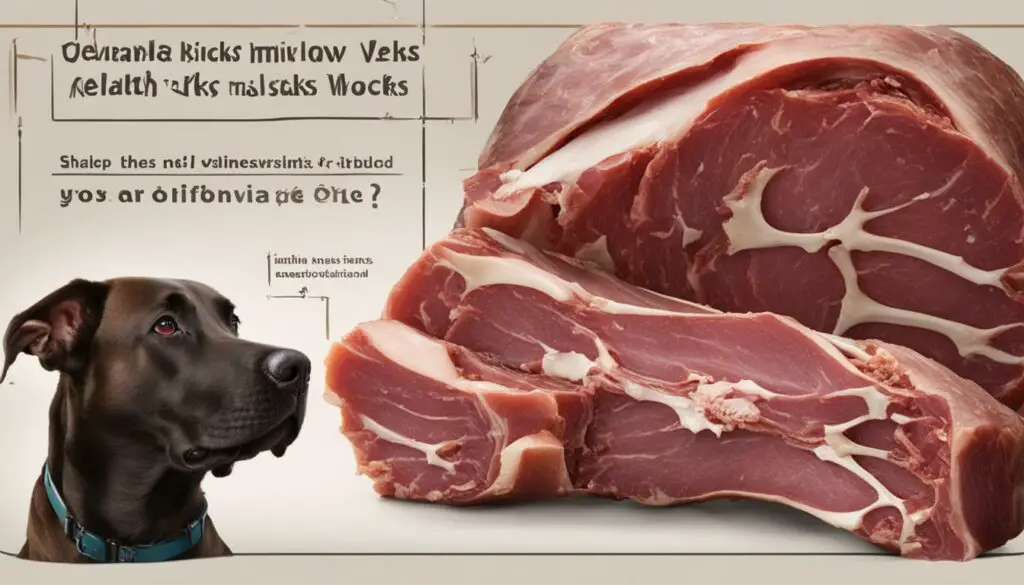
Conclusion
Feeding bones to dogs, including ham hock, poses significant health risks such as broken teeth, mouth and tongue injuries, blockages, and infections. It is crucial to prioritize the safety and well-being of our furry friends by providing safe alternatives for them to chew on. By understanding the potential dangers and offering appropriate chew toys and treats, we can ensure our dogs have a happy, healthy, and risk-free chewing experience.
The Impact of Ham on Dogs
When it comes to ham, it’s important to understand the potential impact it can have on dogs. While ham may be a delicious treat for humans, it can pose significant risks to our furry friends. It’s crucial to prioritize your dog’s health and well-being by avoiding ham and other similar foods.
One of the main concerns with ham is its high salt and fat content. These ingredients can lead to various health issues in dogs, including pancreatitis, which is a serious condition that can cause inflammation of the pancreas. Additionally, ham often contains other ingredients like garlic and onion, which can be toxic to dogs and affect their liver and kidneys.
It’s also important to note that ham can be difficult for dogs to digest, leading to gastrointestinal problems such as upset stomach, vomiting, and diarrhea. These issues can cause discomfort and potentially lead to more severe complications.
| Health Risks of Ham for Dogs | Impact |
|---|---|
| High in salt and fat | Can lead to pancreatitis and other health issues |
| Contains ingredients like garlic and onion | Can be toxic to dogs and affect liver and kidneys |
| Difficult to digest | May cause gastrointestinal problems and discomfort |
Given the potential risks and health complications, it’s best to avoid giving ham to your dogs. Instead, focus on providing them with safe and healthy alternatives that are specifically made for canine consumption. Your dog’s well-being should always be a top priority, and making informed choices about their diet is an essential part of responsible pet ownership.
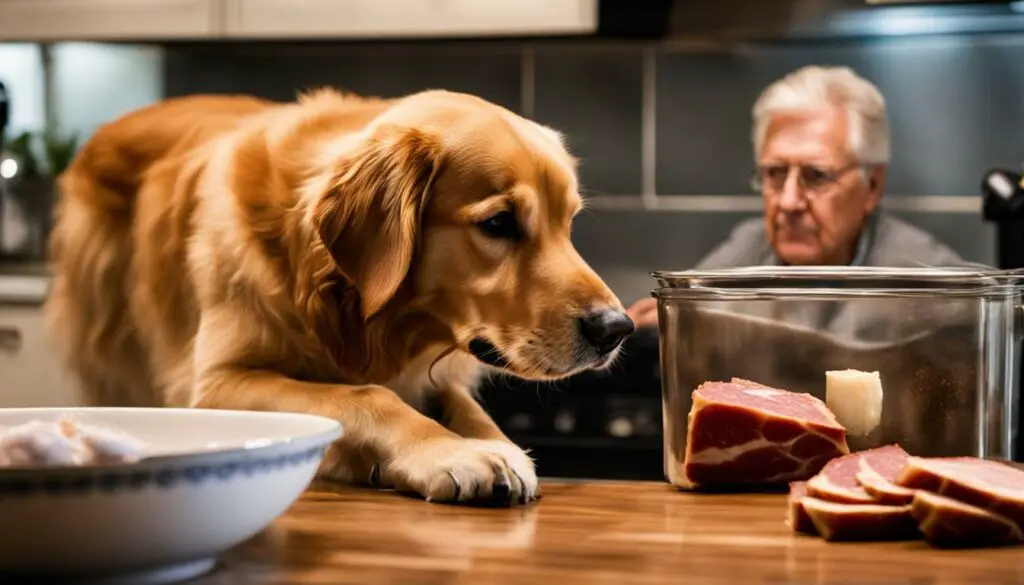
Keeping Your Dog Safe During the Holidays
The holiday season often comes with a variety of delicious foods, including ham hock. However, it is important to prioritize your dog’s safety and avoid sharing these foods with them. High doses of fat and salt can be harmful to dogs, leading to digestive issues and potentially life-threatening conditions. Additionally, other holiday foods like garlic and onion should also be avoided. Being mindful of what you feed your dog can help prevent any potential health risks.
During the holiday season, it is crucial to create a safe environment for your dog to prevent any accidents or health risks. This includes keeping them away from dangerous foods like ham hock and other holiday treats that can be harmful to their health. It is also essential to be mindful of decorations and potential hazards that can pose a risk to your pet’s well-being. Providing a quiet and safe space for your dog and keeping an eye on their behavior can help ensure a happy and healthy holiday season.
Table: Common Holiday Foods to Avoid for Dogs
| Food | Potential Harmful Effects |
|---|---|
| Ham Hock | High fat and salt content, can cause digestive issues |
| Garlic | Toxic to dogs, can affect liver and kidneys |
| Onion | Toxic to dogs, can cause anemia |
| Chocolate | Contains theobromine, toxic to dogs |
| Grapes and Raisins | Can cause kidney failure in dogs |
By being aware of the potential dangers and taking necessary precautions, you can ensure a safe and enjoyable holiday season for both you and your furry friend. Remember to opt for safe alternatives and treats specifically made for dogs, and avoid sharing foods that can be harmful to their health. Prioritizing your dog’s safety and well-being is essential to have a joyful and worry-free holiday season.

Potential Dangers of Christmas Foods for Dogs
During the holiday season, many of us indulge in delicious foods, including ham hock and other treats. However, it’s important to remember that certain foods can pose a danger to our furry friends, including ham bones and other bone treats. The United States Food and Drug Administration (FDA) has received numerous reports of illnesses in dogs associated with these treats, including moldy-appearing bones and splintering bones. To ensure the safety and well-being of our dogs, it is crucial to be aware of these potential dangers and avoid giving them any bones or bone-like products, especially those marketed as ham bones, pork femur bones, rib bones, or pork knuckles.
| Dangerous Christmas Foods for Dogs | Consequences |
|---|---|
| Ham bones | Choking, internal injuries |
| Pork femur bones | Risk of splintering, gastrointestinal issues |
| Rib bones | Injuries to the mouth, tongue, and digestive tract |
| Pork knuckles | Blockages, infections, and other complications |
As pet owners, it’s our responsibility to prioritize the safety and well-being of our dogs. Instead of giving them potentially harmful treats like ham bones, there are safer alternatives available. Visiting your local pet store can provide you with a range of safe treats specifically made for dogs. You can also create interactive games for your dog with treats hidden in the garden or prepare a special meal for them using boneless chicken. By choosing these alternatives, we can ensure that our dogs are able to enjoy the holiday season without any health risks.
“It is crucial to be aware of the potential dangers and avoid giving your dog any bones or bone-like products, especially those marketed as ham bones, pork femur bones, rib bones, or pork knuckles.”
Christmas should be a joyous time for everyone, including our four-legged friends. By being mindful of the potential dangers associated with certain foods and opting for safe alternatives, we can create a safe and enjoyable holiday environment for our dogs. Let’s keep them away from dangerous foods, provide them with treats that are specifically made for them, and ensure a happy and healthy holiday season for all.
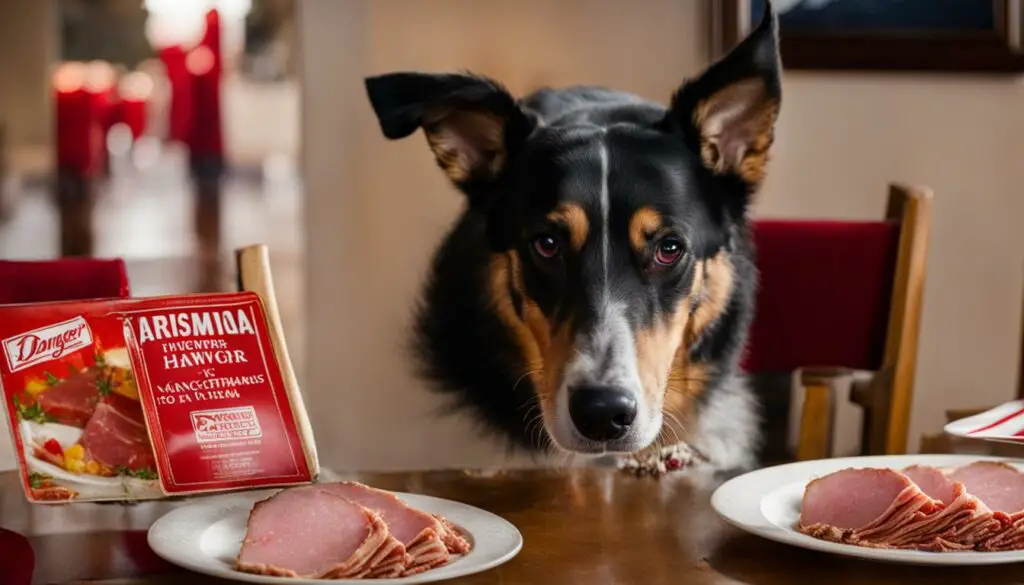
Signs of Illness from Consuming Bone Treats
When dogs consume bone treats, they may experience various signs of illness. It is important for dog owners to be aware of these symptoms to ensure prompt veterinary care. Reported illnesses from bone treats include gastrointestinal obstruction, choking, cuts and wounds in the mouth, vomiting, diarrhea, bleeding from the rectum, and even death.
If your dog exhibits any of these signs after consuming a bone treat, it is crucial to seek immediate veterinary attention. Gastrointestinal obstruction can be life-threatening and may require surgery to remove the blockage. Choking and cuts in the mouth can cause significant discomfort and potential infections. Vomiting, diarrhea, and rectal bleeding may indicate digestive issues that need to be addressed by a professional.
It is essential to monitor your dog closely after giving them any type of bone treat. If you notice any concerning symptoms, do not hesitate to contact your veterinarian. Taking proactive measures to ensure your dog’s health and safety is crucial in preventing further complications from bone treat consumption.
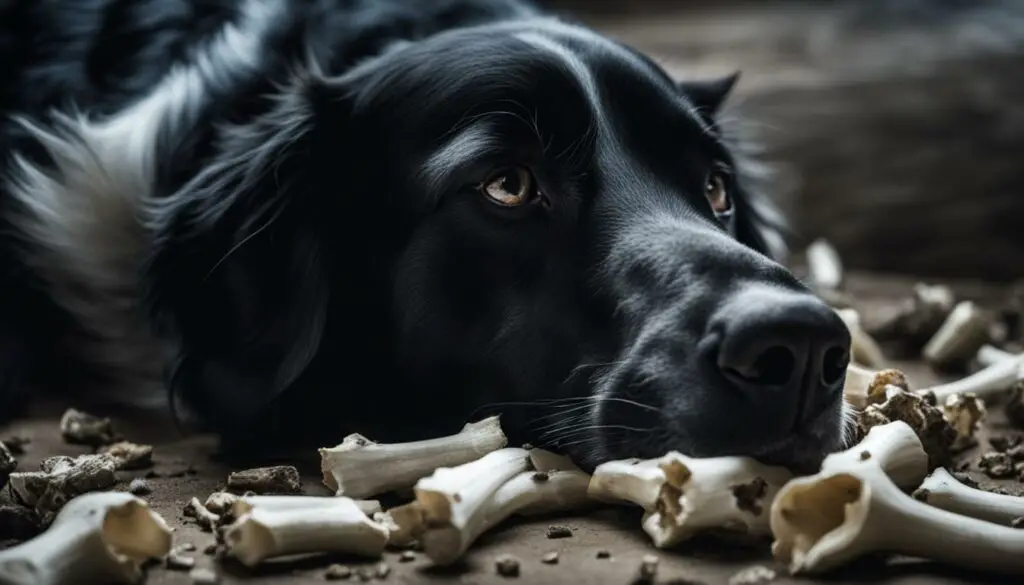
The FDA’s Warnings about Bones for Dogs
When it comes to feeding our canine companions, it’s important to be aware of the potential risks associated with certain foods. One such warning comes from the United States Food and Drug Administration (FDA), which has been cautioning pet owners about the dangers of giving bones to dogs for years. The FDA emphasizes that bones, regardless of their size, are unsafe for dogs and can cause a range of injuries and health issues.
Bones, including ham hock bones, can pose a variety of risks for dogs. They can cause broken teeth, injuries to the mouth and tongue, blocked windpipes, and infections. The cooking process makes bones brittle and more likely to splinter, which can lead to choking and internal injuries. If your dog ingests a bone, it can also result in gastrointestinal blockages and other complications.
Instead of giving your dog bones, it is important to choose safe alternatives for them to chew on. There are many bone-like products available that are made with materials specifically designed to be safe for dogs. These products provide a satisfying chewing experience without the risk of injury. By prioritizing your dog’s safety and avoiding unsafe bones, you can help ensure their overall well-being.
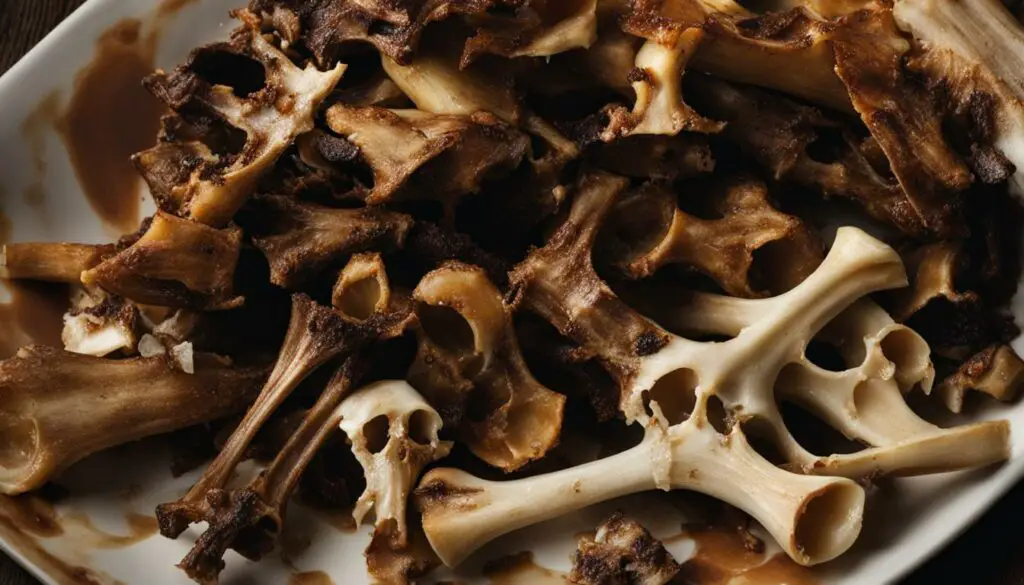
Table: Risks of Giving Bones to Dogs
| Risks | Description |
|---|---|
| Broken Teeth | Bones can cause fractures or breakages in a dog’s teeth. |
| Mouth and Tongue Injuries | Bones can cause cuts or wounds in a dog’s mouth and tongue. |
| Blocked Windpipes | Bones can become lodged in a dog’s throat, causing choking. |
| Infections | Bones can lead to infections in a dog’s digestive tract. |
By being aware of the FDA’s warnings and choosing safe alternatives, you can keep your furry friend happy, healthy, and free from the risks associated with unsafe bones.
Creating a Safe Holiday Environment for Your Dog
During the holiday season, it is important to prioritize your dog’s safety and well-being. There are several holiday dangers for pets that you should be aware of to keep your furry friend out of harm’s way. One crucial aspect of pet safety during the holidays is ensuring that your dog is kept away from dangerous foods. While it may be tempting to share holiday treats with your dog, certain foods can be harmful to their health.
One particular food to keep your dog away from is ham hock. As discussed in previous sections, ham hock can pose various health risks to dogs, including the risk of choking, gastrointestinal obstruction, and injuries to the mouth and digestive tract. The high fat and salt content in ham hock can also lead to digestive issues and potentially life-threatening conditions for your furry friend. It is best to avoid sharing ham hock or any other holiday treats that are not specifically made for dogs.
In addition to keeping your dog away from dangerous foods, it is essential to be mindful of decorations and potential hazards that can pose a risk to your pet’s well-being. Christmas decorations such as tinsel, ornaments, and lights can all be tempting for dogs to play with, but they can also pose a choking hazard or cause injuries. Make sure to secure decorations properly and keep them out of your dog’s reach.
Creating a safe holiday environment for your dog also involves providing them with a quiet and safe space. The holiday season can often be overwhelming for pets due to the increased activity and noise. Set up a designated area where your dog can retreat to whenever they feel anxious or overwhelmed. This safe space can be a quiet room or a comfortable crate where your dog can relax and feel secure.
Holiday Dangers for Pets: A Summary
- Keep your dog away from dangerous foods like ham hock and other holiday treats that are not specifically made for dogs.
- Be mindful of decorations and potential hazards that can pose a risk to your pet’s well-being.
- Provide a quiet and safe space for your dog where they can retreat to when they feel anxious or overwhelmed.

Table: Holiday Foods to Avoid for Dogs
| Foods to Avoid | Reasons to Avoid |
|---|---|
| Ham hock | – Risk of choking and gastrointestinal obstruction – High fat and salt content can lead to health issues |
| Chocolate | – Contains theobromine, which is toxic to dogs – Can cause vomiting, diarrhea, and even heart problems |
| Onions and garlic | – Can cause damage to a dog’s red blood cells – Can lead to anemia and other serious health issues |
| Grapes and raisins | – Can cause kidney failure in dogs – Even small amounts can be toxic |
| Alcohol | – Highly toxic to dogs and can cause serious damage to their liver and nervous system |
By being mindful of holiday dangers for pets and taking necessary precautions, you can ensure that your dog stays safe and healthy throughout the holiday season. Remember, their well-being is in your hands, so make informed decisions and prioritize their safety above all else.
Avoiding Ham Bones After Christmas
After the festive season, it’s crucial to take proper precautions when it comes to ham bones and your furry friends. These cooked bones can become brittle and splinter easily, posing serious risks to dogs. The dangers of ham bones include choking, internal injuries, and blockages in the digestive tract. It’s highly recommended to avoid giving ham bones to your dog altogether to ensure their safety and well-being.
While many pet owners may be tempted to give their dogs bones as a treat, it’s important to consider safe alternatives. Instead of ham bones, opt for chew toys made specifically for dogs. These toys are designed to be durable and provide a safe chewing experience, reducing the risk of injuries. Additionally, bone-like products made with safe materials can be a suitable alternative for your furry friend.
The Risks of Cooked Bones for Dogs
When bones are cooked, they lose their natural flexibility and become brittle. This makes them prone to splintering, which can lead to serious health issues if ingested by dogs. The sharp fragments can cause lacerations in the mouth, throat, and digestive system, and can even puncture organs. The risks of cooked bones for dogs far outweigh any potential benefits, making it imperative to steer clear of giving them to your pets.
It’s important to note that the risks associated with ham bones also extend to other types of cooked bones, such as pork and beef bones. The best course of action is to consult with your veterinarian for safe alternatives and suitable chew toys that promote dental health and provide a healthy outlet for your dog’s natural chewing instincts.
The Importance of Safe Alternatives
Providing your dog with safe alternatives to ham bones is essential for their overall well-being. There are various options available, such as chew toys made of rubber or nylon, which are designed to withstand chewing and are less likely to cause harm. It’s crucial to choose toys that are appropriate for your dog’s size and chewing habits to ensure they can enjoy their chewing experience without any risks.
Safe Treat Options for Dogs
When it comes to treating our furry friends, it’s important to prioritize their health and well-being. Instead of giving your dog potentially harmful treats like ham hock, there are safer alternatives available. Here are some healthy and tasty treat options for dogs:
1. Homemade Dog Treats
One great option is to make your own homemade treats. This way, you have full control over the ingredients and can ensure they are safe and healthy for your dog. There are countless recipes available online that use dog-friendly ingredients like peanut butter, pumpkin, and oats. Just be sure to avoid any harmful ingredients like chocolate or xylitol, which can be toxic to dogs.
2. Commercially Available Dog Treats
Another option is to purchase commercially available dog treats. Look for trusted brands that prioritize quality and safety in their products. Read the ingredient list carefully to ensure there are no harmful additives or preservatives. Opt for treats made with natural ingredients that are specifically formulated for dogs. Many pet stores carry a wide variety of safe options to choose from.
3. Fruits and Vegetables
Certain fruits and vegetables can make excellent treats for dogs. Apples, carrots, and blueberries are just a few examples of dog-friendly fruits and vegetables that can be given as treats. Just make sure to remove any seeds or pits and cut them into appropriate-sized pieces. Remember to introduce new foods gradually and in moderation to avoid any digestive issues.
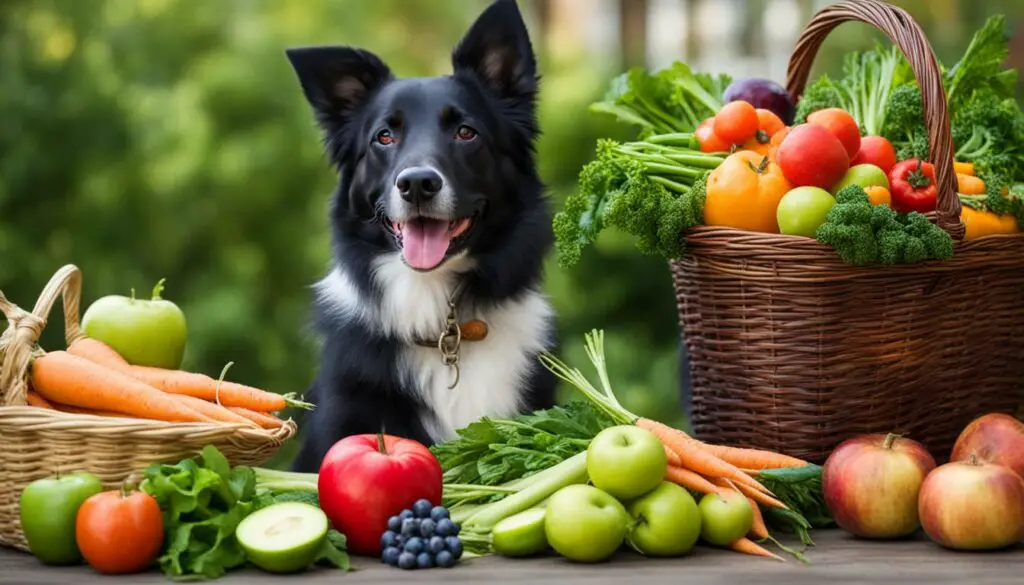
Remember, while treats can be enjoyable for dogs, they should only make up a small portion of their overall diet. It’s important to feed your dog a balanced and nutritious diet that meets their specific needs. Always consult with your veterinarian before introducing any new treats or dietary changes for your dog.
Putting Dogs First with Yitto Paws
When it comes to the safety and well-being of our beloved canine companions, choosing the right products is of utmost importance. That’s why I’m excited to introduce Yitto Paws, a company dedicated to putting dogs first and offering a range of safe and healthy products for pets.
At Yitto Paws, they prioritize using organic ingredients in their products, ensuring that pet owners can trust what they are giving their dogs. With a commitment to transparency, Yitto Paws provides pet owners with peace of mind, knowing that they are making a responsible choice for their furry friends.
From delicious and nutritious treats to innovative toys and accessories, Yitto Paws has a wide range of products to cater to the unique needs of every dog. Whether you’re looking for a special treat to reward your pup or a durable chew toy to keep them entertained, Yitto Paws has it all.
By supporting companies like Yitto Paws, pet owners can make a difference and contribute to the well-being and safety of their furry friends. So, let’s put our dogs first and choose Yitto Paws for all their pet product needs.
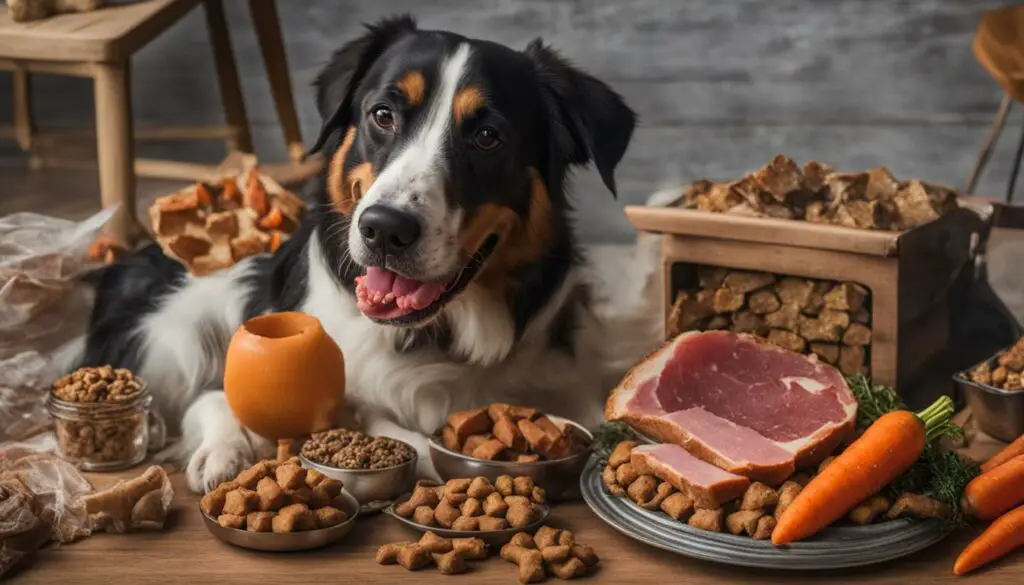
Conclusion
After gathering all the facts, it is clear that ham hock is not safe for dogs. The United States Food and Drug Administration (FDA) warns against giving dogs any type of bone, including ham bones. These treats have been associated with various health issues in dogs, such as gastrointestinal obstruction, choking, and injuries to the mouth and digestive tract. Consuming ham hock can also lead to gastrointestinal issues and potentially life-threatening conditions.
It is crucial to prioritize your dog’s safety and well-being by avoiding ham hock and other bone treats. Instead, opt for safe alternatives and treats specifically made for dogs. You can find a range of safe treats at your local pet store or even create interactive games for your dog with hidden treats in the garden. Additionally, companies like Yitto Paws offer organic and healthy products for pets, ensuring you can trust what you’re giving your furry friend.
Remember, during the holiday season and throughout the year, it’s important to be mindful of what you feed your dog. High doses of fat and salt, like those found in ham hock, can be harmful to dogs and lead to serious health issues. By prioritizing your dog’s health and well-being, you can ensure they have a happy and healthy life.
FAQ
Can dogs eat ham hock?
No, ham hock can be dangerous for dogs. When cooked, ham hock becomes brittle and can easily splinter, posing a risk of choking and internal injuries. Consuming pork hock can also lead to gastrointestinal issues, such as blockages and pancreatitis.
Are bones safe for dogs?
No, giving dogs bones, including ham hock, can have serious health risks. Bones can cause broken teeth, injuries to the mouth and tongue, and blockages in the digestive tract. Ingesting bones can also lead to infections and other complications.
Is ham safe for dogs?
Ham, especially in high doses, can be harmful to dogs. It is typically high in salt and fat, which can lead to health issues such as pancreatitis. Other ingredients commonly found in ham, such as garlic and onion, can also be toxic to dogs, affecting their liver and kidneys.
How can I keep my dog safe during the holiday season?
It is important to create a safe environment for your dog by keeping them away from dangerous foods like ham hock and other holiday treats that can be harmful to their health. Also, be mindful of decorations and potential hazards that can pose a risk to your pet’s well-being.
What are the dangers of giving dogs ham bones?
Ham bones, like other bone treats, have been associated with illnesses in dogs. These treats can cause gastrointestinal obstruction, choking, cuts and wounds in the mouth, vomiting, diarrhea, bleeding from the rectum, and even death.
What are the signs of illness from consuming bone treats?
Dogs that have consumed bone treats may exhibit symptoms such as gastrointestinal obstruction, choking, cuts and wounds in the mouth, vomiting, diarrhea, bleeding from the rectum, and even death.
Why are bones unsafe for dogs?
Bones, regardless of their size, can cause injuries such as broken teeth, mouth and tongue injuries, blocked windpipes, and infections in dogs. It is important to choose safe alternatives for dogs to chew on.
How do I dispose of leftover ham bones properly?
After Christmas, it is recommended to properly dispose of any leftover ham bones. Ham bones, when cooked, become brittle and can splinter easily, posing a risk of choking and internal injuries to dogs. It is best to avoid giving ham bones to your dog altogether.
What are safe treat options for dogs?
Instead of giving potentially harmful treats like ham hock, there are safer alternatives available. Visiting your local pet store can provide you with a range of safe treats specifically made for dogs. You can also create interactive games for your dog with treats hidden in the garden or prepare a special meal for them using boneless chicken.
What is Yitto Paws?
Yitto Paws is a company dedicated to putting dogs first and offering safe and healthy products for pets. They prioritize organic ingredients and transparency in their products, ensuring pet owners can trust what they are giving their dogs.

